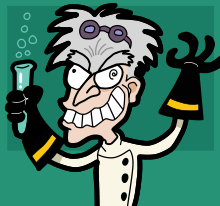Gag cartoon
| Comics |
|---|
| Comics studies |
| Methods |
| Media |
| Community |
|
|
A gag cartoon (a.k.a. panel cartoon or gag panel) is most often a single-panel cartoon, usually including a caption beneath the drawing. A pantomime cartoon carries no caption. In some cases, dialogue may appear in speech balloons, following the common convention of comic strips.
As the name implies—"gag" being a show business term for a comedic idea—these cartoons are most often intended to provoke laughter. Popular magazines that have featured gag cartoons include Punch, The New Yorker and Playboy. Some publications, such as Humorama, have used cartoons as the main focus of the magazine, rather than articles and fiction.
Captions
Captions are usually concise, to fit on a single line. Gag cartoons of the 1930s and earlier occasionally had lengthy captions, sometimes featuring dialogue between two characters depicted in the drawing; over time, cartoon captions became shorter. A well-known 1928 cartoon in The New Yorker, drawn by Carl Rose and captioned by E. B. White, shows a mother trying to convince her young daughter to finish her meal. "It's broccoli, dear." "I say it's spinach and I say the hell with it."
Markets
In the mid-1950s, gag cartoonists found a new market with the introduction of highly popular studio cards in college bookstores. Single-panel cartoons have been published on various products, such as coffee mugs and cocktail napkins.
Traditionally, newspapers and magazines printed cartoons in black and white, but this changed in the 1950s when Playboy began to feature full-page, full-color cartoons in every issue.
Books
There are numerous collections of cartoons in both paperback and hardcover, notably The New Yorker collections. From 1942 to 1971, the cartoonist-novelist Lawrence Lariar edited the annual Best Cartoons of the Year collections.[1]
Notable gag cartoonists
- Charles Addams
- Sam Cobean
- Peter Arno
- George Booth
- Roz Chast
- George Clark
- Sam Gross
- Gary Larson
- George Lichty
- Virgil Partch (a.k.a. VIP)
- George Price
- Ronald Searle
- James Thurber
- Gluyas Williams
- Gahan Wilson
- Jean-Jacques Sempé
- R. K. Laxman
Popular themes
There are some well-established themes which recur regularly in gag cartoons. These themes are often adapted to suit the context of the cartoon. Popular themes include:
See also
-
 Comics portal
Comics portal -
 Cartoon portal
Cartoon portal - Daily strip
- Gag-a-day
- Editorial cartoon
- List of cartoonists
- Gag-a-day